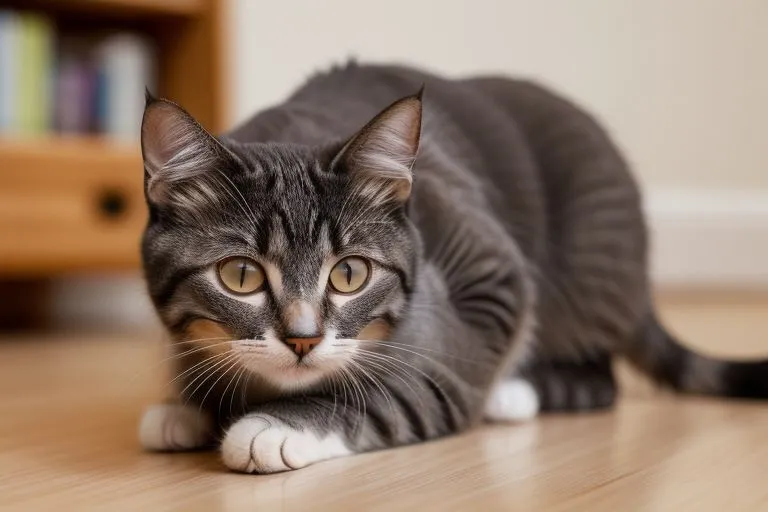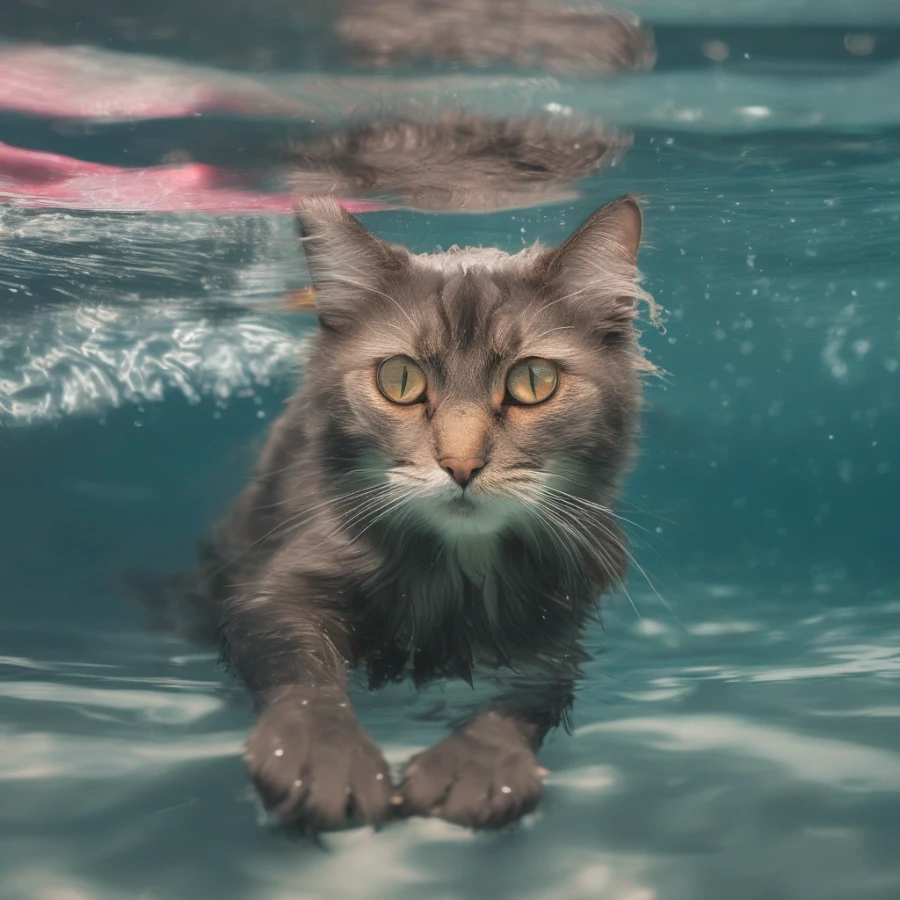Whisker Wellness: The Ultimate Guide to Cat Whisker Care

Published by: Tatsiana Korshik
Time to Read: 10 Min

Cat whiskers are vital sensory tools, central to your cat's daily life and overall well-being. These delicate, hair-like structures serve a profound purpose in helping your feline friend navigate its surroundings with precision.
Sensory Prowess: Cat whiskers are more than meets the eye. Made of keratin, the same protein found in human hair and nails, these sensitive structures house nerve endings that elevate your cat's sensory abilities. Their wide span acts as a natural measuring system, aiding your cat in gauging distances and navigating through various spaces.
Navigating the World: Watch your cat move gracefully through tight spots or execute precise jumps. These actions are guided by the sophisticated detection system of their whiskers. The whiskers' wider span than the body enables your cat to make accurate decisions based on real-time assessments of its environment.
Communication and Well-Being: Cat whiskers also play a role in feline communication. When forward-facing, they signal curiosity or excitement, while pulled back against the face may indicate fear or unease. Understanding these cues enhances the environment for your cat, contributing to its overall well-being.
In this guide, we explore the intricacies of cat whiskers, shedding light on their anatomy, purpose, and practical care tips. Join us in unraveling the mysteries behind these silent communicators and guardians of your cat's world.
The primary function of cat whiskers lies in providing valuable information about their surroundings. Acting as a sophisticated guidance system, these whiskers help cats navigate their environment with remarkable precision. Their wider span compared to the body allows cats to gauge distances, making them particularly adept at moving through tight spaces and executing precise jumps.
To grasp the importance of whiskers, picture your cat effortlessly maneuvering through a cluttered area or accurately judging the height of a jump. These actions are a testament to the whiskers' role in real-time environmental assessment.
Beyond navigation, cat whiskers also serve as a form of communication. When your cat's whiskers are forward-facing, it signals curiosity or excitement. Conversely, whiskers pulled back against the face may indicate fear or discomfort. Understanding and respecting these signals contribute to fostering a positive environment for your cat.
In summary, whiskers are indispensable tools for your cat's sensory perception. They facilitate navigation, communication, and overall well-being. As we delve deeper into this guide, we will uncover more aspects of whiskers, including their anatomy, practical care, and tips for ensuring your cat's whiskers remain in optimal condition. Cat whiskers, scientifically known as vibrissae, have a specialized structure that goes beyond their outward appearance. The whiskers are deeply embedded in a cat's body and are connected to the nervous system, making them highly sensitive and essential for the cat's overall sensory experience.
Cat whiskers, scientifically known as vibrissae, have a specialized structure that goes beyond their outward appearance. The whiskers are deeply embedded in a cat's body and are connected to the nervous system, making them highly sensitive and essential for the cat's overall sensory experience.
Structure: Cat whiskers are longer, stiffer, and more deeply embedded than regular hairs. The base of each whisker is surrounded by a dense network of nerves and blood vessels, enhancing their sensitivity. This structural design allows whiskers to pick up even the slightest changes in the surrounding environment.
Sensory Receptors and Their Function: At the core of cat whiskers' functionality are sensory receptors, particularly mechanoreceptors. These receptors respond to mechanical stimuli, such as touch and vibrations. As a cat moves through its environment, the whiskers detect changes in air currents and the touch of nearby objects. The information gathered by the whiskers is then transmitted to the nervous system, providing the cat with real-time feedback about its surroundings.
Cat whiskers serve a multifaceted purpose, playing a crucial role in a cat's ability to navigate and perceive its surroundings with precision.
Navigation: Whiskers act as an extension of a cat's sense of touch, allowing them to navigate spaces with accuracy. For instance, when exploring a confined area, a cat's whiskers will touch the surfaces, providing information about the size of openings and potential obstacles. This tactile feedback helps cats make decisions about movement and avoid collisions.
Perceiving Surroundings: In addition to tactile input, whiskers assist cats in perceiving their surroundings. They can detect changes in air currents, aiding cats in sensing approaching objects, even in low-light conditions. This heightened perception is particularly valuable in hunting and maintaining awareness of potential threats.
Exploration in Darkness: In low-light conditions, a cat's whiskers help it navigate and explore without relying solely on its vision. Precision Jumping:
When making precise jumps, especially in cluttered spaces, a cat extends its whiskers forward to gauge the distance accurately. Hunting Instincts:
During hunting, a cat's whiskers play a crucial role in detecting the position and movement of prey, contributing to a successful catch. Understanding the intricate anatomy and functionality of cat whiskers provides insight into the cat's remarkable sensory capabilities and highlights the importance of caring for these sensitive structures.
When selecting bowls for your cat's meals, prioritize wide and shallow options. These dimensions are crucial to prevent whisker stress, a discomfort that can arise when a cat's sensitive whiskers touch the sides of deep bowls.
Opting for wide and shallow bowls ensures that your cat's whiskers remain untouched during mealtime, promoting a more relaxed and enjoyable dining experience. Whisker stress can lead to reluctance during meals, affecting your cat's overall well-being.
To create a whisker-friendly feeding area, consider the following tips:
1. Wide and Shallow Bowls:
Choose bowls that allow your cat to access its food without its whiskers touching the sides. This small adjustment can make a significant difference in your cat's comfort during meals.
2. Multiple Small Meals:
Divide your cat's daily meals into smaller portions. This not only prevents overfilling the bowl but also reduces whisker stress during feeding. Identify behavioral cues indicating whisker stress. Observe if your cat flattens its whiskers against its face, avoids eating or drinking from its bowls, increases hiding behavior, or displays heightened aggression or irritability. These signs may indicate stress or anxiety in your cat.
Identify behavioral cues indicating whisker stress. Observe if your cat flattens its whiskers against its face, avoids eating or drinking from its bowls, increases hiding behavior, or displays heightened aggression or irritability. These signs may indicate stress or anxiety in your cat.
Explain how stress can affect a cat's overall well-being: Prolonged stress can negatively impact your cat's physical health, potentially leading to digestive issues, skin problems, or a weakened immune system. Additionally, stress may manifest in changes to your cat's behavior, such as increased vocalization, excessive grooming, or withdrawal from social interactions.
Creating a Stress-Free Environment: Provide practical tips for minimizing stress at home. Designate quiet, comfortable spaces where your cat can retreat when feeling overwhelmed. Establish a consistent daily routine for feeding, play, and rest to reduce uncertainty. Create safe hideouts using cat beds, cozy blankets, or covered spaces, offering your cat a secure and stress-free zone. Provide interactive toys to engage your cat mentally and physically, serving as a positive outlet for stress and energy.
By understanding and addressing signs of whisker stress, you can actively contribute to a harmonious home environment for your cat. Implementing stress-reducing strategies enhances your cat's overall well-being and ensures they lead a happy and healthy life.
1. Observation: Take a moment to observe your cat's whiskers. Ensure they appear symmetrical and are not broken or damaged. Healthy whiskers contribute to your cat's sensory perception and overall health.
2. Gentle Touch: Gently touch and feel your cat's whiskers. They should be firm and not excessively brittle. If you notice any unusual texture, it could indicate a need for closer inspection.
3. Check for Debris: Examine the whiskers for any foreign debris or substances. Cats can sometimes get into situations that may leave residue on their whiskers, affecting their functionality.
By incorporating these simple whisker health checks into your routine, you can contribute to the overall well-being of your feline friend. If you ever notice anything unusual or have concerns about your cat's whiskers, don't hesitate to seek guidance from your veterinarian.
Summarize Key Points: We've explored the intricate anatomy of cat whiskers, highlighting their role as vital sensory tools. These whiskers, equipped with sensory receptors, aid cats in navigating their surroundings with precision.
Recap the Importance of Whiskers in a Cat's Life: Whiskers are not merely decorative; they are sophisticated instruments that contribute to a cat's sensory perception. From precise navigation to communication, healthy whiskers are essential for a cat's daily life.
Encourage Cat Owners to Prioritize Whisker Wellness: As responsible cat owners, it's crucial to prioritize whisker wellness. Choosing wide and shallow bowls, creating a stress-free environment, and performing regular whisker health checks are simple yet effective ways to contribute to your cat's well-being.
By actively incorporating these practices into your cat care routine, you ensure a happy and healthy life for your feline friend. Remember, whisker wellness is not just about physical health but also contributes to your cat's mental and emotional well-being.
Cat whiskers are crucial for sensory perception. They help cats navigate their environment, gauge distances, and communicate. Healthy whiskers contribute to a cat's overall well-being.
How do I choose a whisker-friendly cat bowl?
Opt for wide and shallow bowls to prevent whisker stress. Deep bowls may cause discomfort. Choosing whisker-friendly bowls ensures a stress-free dining experience for your cat.
What are signs of whisker stress in cats?
Signs include flattening of whiskers against the face, avoiding food bowls, increased hiding behavior, and heightened aggression or irritability. These cues may indicate stress or anxiety.
How can I create a stress-free environment for my cat?
Designate quiet retreats, establish a consistent daily routine, provide safe hideouts, and use interactive toys. These practices contribute to a stress-free environment for your cat.
Why should I perform a whisker health check?
Regular whisker inspections help ensure your cat's well-being. Changes in whisker length, inflammation, or excessive shedding may indicate health issues. Early intervention is crucial for proper care.
How often should I perform a whisker health check?
Aim for regular checks during grooming sessions. Depending on your cat's breed and lifestyle, monthly or bi-monthly inspections should be sufficient. Always be attentive to any changes.
Can stress affect a cat's physical health?
Yes, prolonged stress can negatively impact a cat's physical health. It may lead to digestive issues, skin problems, or a weakened immune system. Managing stress is crucial for overall well-being.
How can I encourage my cat to use a designated safe space?
Make the designated space cozy with cat beds, blankets, or covered areas. Positive reinforcement, treats, and gentle encouragement can help your cat associate the space with safety and comfort.
Sensory Prowess: Cat whiskers are more than meets the eye. Made of keratin, the same protein found in human hair and nails, these sensitive structures house nerve endings that elevate your cat's sensory abilities. Their wide span acts as a natural measuring system, aiding your cat in gauging distances and navigating through various spaces.
Navigating the World: Watch your cat move gracefully through tight spots or execute precise jumps. These actions are guided by the sophisticated detection system of their whiskers. The whiskers' wider span than the body enables your cat to make accurate decisions based on real-time assessments of its environment.
Communication and Well-Being: Cat whiskers also play a role in feline communication. When forward-facing, they signal curiosity or excitement, while pulled back against the face may indicate fear or unease. Understanding these cues enhances the environment for your cat, contributing to its overall well-being.
In this guide, we explore the intricacies of cat whiskers, shedding light on their anatomy, purpose, and practical care tips. Join us in unraveling the mysteries behind these silent communicators and guardians of your cat's world.
Understanding Whiskers
Cat whiskers are not merely decorative; they are intricate sensory instruments crucial to your cat's daily life. These hair-like structures, made of keratin, possess nerve endings that significantly enhance your cat's sensory perception.The primary function of cat whiskers lies in providing valuable information about their surroundings. Acting as a sophisticated guidance system, these whiskers help cats navigate their environment with remarkable precision. Their wider span compared to the body allows cats to gauge distances, making them particularly adept at moving through tight spaces and executing precise jumps.
To grasp the importance of whiskers, picture your cat effortlessly maneuvering through a cluttered area or accurately judging the height of a jump. These actions are a testament to the whiskers' role in real-time environmental assessment.
Beyond navigation, cat whiskers also serve as a form of communication. When your cat's whiskers are forward-facing, it signals curiosity or excitement. Conversely, whiskers pulled back against the face may indicate fear or discomfort. Understanding and respecting these signals contribute to fostering a positive environment for your cat.
In summary, whiskers are indispensable tools for your cat's sensory perception. They facilitate navigation, communication, and overall well-being. As we delve deeper into this guide, we will uncover more aspects of whiskers, including their anatomy, practical care, and tips for ensuring your cat's whiskers remain in optimal condition.
Anatomy of Cat Whiskers
 Cat whiskers, scientifically known as vibrissae, have a specialized structure that goes beyond their outward appearance. The whiskers are deeply embedded in a cat's body and are connected to the nervous system, making them highly sensitive and essential for the cat's overall sensory experience.
Cat whiskers, scientifically known as vibrissae, have a specialized structure that goes beyond their outward appearance. The whiskers are deeply embedded in a cat's body and are connected to the nervous system, making them highly sensitive and essential for the cat's overall sensory experience.
Structure: Cat whiskers are longer, stiffer, and more deeply embedded than regular hairs. The base of each whisker is surrounded by a dense network of nerves and blood vessels, enhancing their sensitivity. This structural design allows whiskers to pick up even the slightest changes in the surrounding environment.
Sensory Receptors and Their Function: At the core of cat whiskers' functionality are sensory receptors, particularly mechanoreceptors. These receptors respond to mechanical stimuli, such as touch and vibrations. As a cat moves through its environment, the whiskers detect changes in air currents and the touch of nearby objects. The information gathered by the whiskers is then transmitted to the nervous system, providing the cat with real-time feedback about its surroundings.
The Purpose of Whiskers:
Cat whiskers serve a multifaceted purpose, playing a crucial role in a cat's ability to navigate and perceive its surroundings with precision.
Navigation: Whiskers act as an extension of a cat's sense of touch, allowing them to navigate spaces with accuracy. For instance, when exploring a confined area, a cat's whiskers will touch the surfaces, providing information about the size of openings and potential obstacles. This tactile feedback helps cats make decisions about movement and avoid collisions.
Perceiving Surroundings: In addition to tactile input, whiskers assist cats in perceiving their surroundings. They can detect changes in air currents, aiding cats in sensing approaching objects, even in low-light conditions. This heightened perception is particularly valuable in hunting and maintaining awareness of potential threats.
Real-Life Examples of Whiskers in Action:
Exploration in Darkness: In low-light conditions, a cat's whiskers help it navigate and explore without relying solely on its vision. Precision Jumping:
When making precise jumps, especially in cluttered spaces, a cat extends its whiskers forward to gauge the distance accurately. Hunting Instincts:
During hunting, a cat's whiskers play a crucial role in detecting the position and movement of prey, contributing to a successful catch. Understanding the intricate anatomy and functionality of cat whiskers provides insight into the cat's remarkable sensory capabilities and highlights the importance of caring for these sensitive structures.
Whisker-Friendly Feeding
Choosing Cat Bowls
When selecting bowls for your cat's meals, prioritize wide and shallow options. These dimensions are crucial to prevent whisker stress, a discomfort that can arise when a cat's sensitive whiskers touch the sides of deep bowls.
Opting for wide and shallow bowls ensures that your cat's whiskers remain untouched during mealtime, promoting a more relaxed and enjoyable dining experience. Whisker stress can lead to reluctance during meals, affecting your cat's overall well-being.
Feeding Arrangements
To create a whisker-friendly feeding area, consider the following tips:
1. Wide and Shallow Bowls:
Choose bowls that allow your cat to access its food without its whiskers touching the sides. This small adjustment can make a significant difference in your cat's comfort during meals.
2. Multiple Small Meals:
Divide your cat's daily meals into smaller portions. This not only prevents overfilling the bowl but also reduces whisker stress during feeding.
Signs of Whisker Stress
 Identify behavioral cues indicating whisker stress. Observe if your cat flattens its whiskers against its face, avoids eating or drinking from its bowls, increases hiding behavior, or displays heightened aggression or irritability. These signs may indicate stress or anxiety in your cat.
Identify behavioral cues indicating whisker stress. Observe if your cat flattens its whiskers against its face, avoids eating or drinking from its bowls, increases hiding behavior, or displays heightened aggression or irritability. These signs may indicate stress or anxiety in your cat.
Explain how stress can affect a cat's overall well-being: Prolonged stress can negatively impact your cat's physical health, potentially leading to digestive issues, skin problems, or a weakened immune system. Additionally, stress may manifest in changes to your cat's behavior, such as increased vocalization, excessive grooming, or withdrawal from social interactions.
Creating a Stress-Free Environment: Provide practical tips for minimizing stress at home. Designate quiet, comfortable spaces where your cat can retreat when feeling overwhelmed. Establish a consistent daily routine for feeding, play, and rest to reduce uncertainty. Create safe hideouts using cat beds, cozy blankets, or covered spaces, offering your cat a secure and stress-free zone. Provide interactive toys to engage your cat mentally and physically, serving as a positive outlet for stress and energy.
By understanding and addressing signs of whisker stress, you can actively contribute to a harmonious home environment for your cat. Implementing stress-reducing strategies enhances your cat's overall well-being and ensures they lead a happy and healthy life.
Whisker Health Check
As a cat owner, it's essential to perform routine checks on your cat's whiskers to ensure their well-being. Here's a simple guide to help you with the process:1. Observation: Take a moment to observe your cat's whiskers. Ensure they appear symmetrical and are not broken or damaged. Healthy whiskers contribute to your cat's sensory perception and overall health.
2. Gentle Touch: Gently touch and feel your cat's whiskers. They should be firm and not excessively brittle. If you notice any unusual texture, it could indicate a need for closer inspection.
3. Check for Debris: Examine the whiskers for any foreign debris or substances. Cats can sometimes get into situations that may leave residue on their whiskers, affecting their functionality.
Highlight Signs of Potential Health Issues:
Recognizing signs of potential health issues related to your cat's whiskers is crucial for early intervention. Be vigilant for the following: sudden changes in whisker length, which may indicate a health problem; inflammation or redness around the base of the whiskers, signaling a potential underlying issue; and excessive whisker shedding, as while shedding is natural, an unusual pattern in whisker loss may be a cause for concern. If you observe any irregularities, it's advisable to consult with your veterinarian for a professional assessment.By incorporating these simple whisker health checks into your routine, you can contribute to the overall well-being of your feline friend. If you ever notice anything unusual or have concerns about your cat's whiskers, don't hesitate to seek guidance from your veterinarian.
Conclusion: Prioritizing Whisker Wellness for Your Cat
In conclusion, understanding and prioritizing the wellness of your cat's whiskers is paramount for their overall health and happiness.Summarize Key Points: We've explored the intricate anatomy of cat whiskers, highlighting their role as vital sensory tools. These whiskers, equipped with sensory receptors, aid cats in navigating their surroundings with precision.
Recap the Importance of Whiskers in a Cat's Life: Whiskers are not merely decorative; they are sophisticated instruments that contribute to a cat's sensory perception. From precise navigation to communication, healthy whiskers are essential for a cat's daily life.
Encourage Cat Owners to Prioritize Whisker Wellness: As responsible cat owners, it's crucial to prioritize whisker wellness. Choosing wide and shallow bowls, creating a stress-free environment, and performing regular whisker health checks are simple yet effective ways to contribute to your cat's well-being.
By actively incorporating these practices into your cat care routine, you ensure a happy and healthy life for your feline friend. Remember, whisker wellness is not just about physical health but also contributes to your cat's mental and emotional well-being.
FAQs: Whisker Wellness for Your Cat
Why are cat whiskers important?Cat whiskers are crucial for sensory perception. They help cats navigate their environment, gauge distances, and communicate. Healthy whiskers contribute to a cat's overall well-being.
How do I choose a whisker-friendly cat bowl?
Opt for wide and shallow bowls to prevent whisker stress. Deep bowls may cause discomfort. Choosing whisker-friendly bowls ensures a stress-free dining experience for your cat.
What are signs of whisker stress in cats?
Signs include flattening of whiskers against the face, avoiding food bowls, increased hiding behavior, and heightened aggression or irritability. These cues may indicate stress or anxiety.
How can I create a stress-free environment for my cat?
Designate quiet retreats, establish a consistent daily routine, provide safe hideouts, and use interactive toys. These practices contribute to a stress-free environment for your cat.
Why should I perform a whisker health check?
Regular whisker inspections help ensure your cat's well-being. Changes in whisker length, inflammation, or excessive shedding may indicate health issues. Early intervention is crucial for proper care.
How often should I perform a whisker health check?
Aim for regular checks during grooming sessions. Depending on your cat's breed and lifestyle, monthly or bi-monthly inspections should be sufficient. Always be attentive to any changes.
Can stress affect a cat's physical health?
Yes, prolonged stress can negatively impact a cat's physical health. It may lead to digestive issues, skin problems, or a weakened immune system. Managing stress is crucial for overall well-being.
How can I encourage my cat to use a designated safe space?
Make the designated space cozy with cat beds, blankets, or covered areas. Positive reinforcement, treats, and gentle encouragement can help your cat associate the space with safety and comfort.



